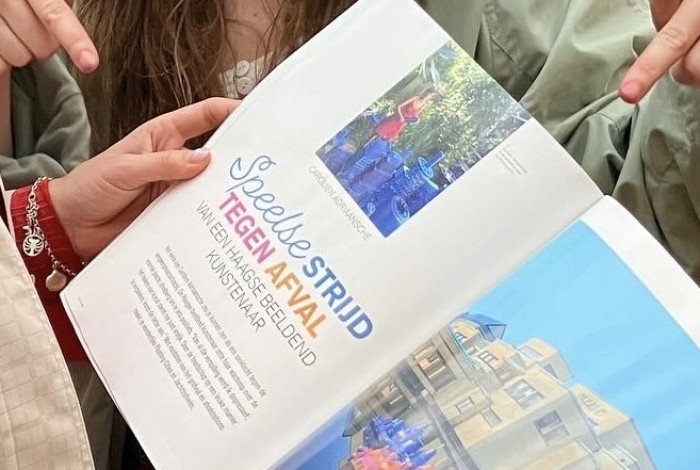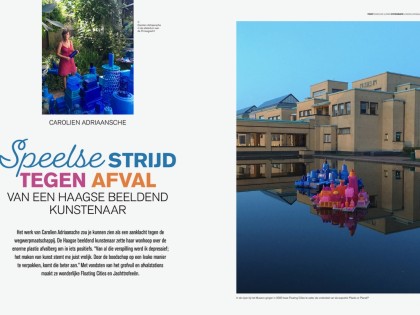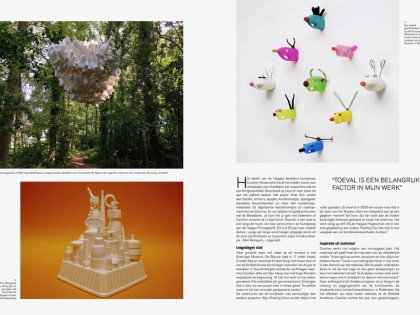Leven Magazine Den Haag
22 May 2024

A visual artist from The Hague's playful battle against waste.
Carolien Adriaansche's work could be seen as an indictment of the throwaway society. The visual artist from The Hague turned her despair about the huge plastic waste mountain into something positive. "All that waste depressed me; making art actually makes me happy. By packaging the message in a fun way, it comes across better." Using finds from the junkyard and waste stations, she makes wondrous Floating Cities and Hunting Trophies.
The Hague-based visual artist Carolien Adriaansche's studio is somewhere between a workshop, a waste depot, an exhibition space and a thrift shop. Sorted by colour and shape, bins of waste plastic stand up to the ceiling. A world of bottles, buckets, caps, garlic nets, toys, slides, building materials and more. From packaging materials to discarded cutlery baskets from Zwennes dishwashers. And from ice boxes to pipette tip holders from the Blood Bank. You name it, Carolien incorporates it into her art. Some of this can be seen along the walls of her workspace in Kunstgreep on Prinsegracht in The Hague. This has been her creative domain for 25 years. Along a long wall hang funny animals from the Hunting Trophies series and in between are miniature cities - Mini Metropolis - displayed.
Disengaged city
Her largest work ever is currently at the Groninger Museum. The Blue City is 11 metres wide, 2 metres deep and up to 3 metres high. It is part of the Children's Biennial, which can be visited until early November this year. In terms of dimensions, the truck Carolien used to move everything from The Hague to the far north formed the boundary. "I created the work in my studio. All parts were numbered and in Groningen I put everything back together like a puzzle. On site, some things had to be repaired."
The construction of this artwork was simpler than previous projects. "My Floating Cities are always placed in water. In 2020, for instance, an orange-pink city floated in the pond in front of the Museon. At one point, due to a twisting wind, the rope attaching the work to the bottom was completely twisted and the anchor came loose. The work went adrift. Near the Haagse Hogeschool, a piece of plasterboard fell onto another Floating City. Then I put on my wading suit to do repairs."
Inspiration from material
Carolien does not work according to a preconceived plan. The material itself gives her the inspiration for the final creation. "I love shapes, structures and always choose bright colours. Coincidence is an important factor in my work; I am subservient to the material. With the plastic parts, I build like with Lego. I do not make any modifications and do not colour the material myself. Too obvious shapes like sandbox moulds I find too contrived and therefore not interesting."
Her background as a theatre designer is reflected in the scale and expressiveness of the artworks. She first studied interior design in Rotterdam. After dropping out, she completed the Rietveld Academy. Carolien worked for ten years for companies, including Stella The Hague. She also made free work with plastic waste. For instance, she devised her own animal species, which were the first to be exhibited at the National History Museum in Rotterdam.
"The Hunting Trophies series started with bottles of cleaning products in which I suddenly saw animal heads. To that I added noses from caps and ears from clothes hangers." A number of trophies have been acquired by the Museum of Natural History and Science in Lisbon, the European Parliament in Brussels, Gasunie in Groningen and private individuals at home and abroad.
Finds
When theatre work could no longer be combined with her young children, she found herself in the classroom as a professional artist. Her name was the Waste Teacher. In the beginning, Carolien scoured the junkyard hoping to find brightly coloured crates or a laundry basket. "I also snooped in construction containers to find waste materials. It's always a surprise what you come across. Acquaintances I asked to keep plastic waste for me. As a souvenir from foreign holidays, I always took detergent bottles with me. At one point, I had so much of it that when I visited somewhere, I brought a milk carton of detergent instead of a bottle of wine. For the workshops at schools, I soon needed more material. At the Haagse Markt, I made arrangements with merchants to keep plastic packaging material for me. I also made contact with companies. At white goods retailer Zwennes, she collects, among other things, cutlery trays from dishwashers. After long insistence, she can pick out special plastic pieces at the Haagse Milieu Service."
Faster awareness
With her creations, Carolien draws attention to overconsumption and its consequences for our earth. The transition is not going fast enough for her. "Plastic is a cheap material and people attach little value to it. Personally, I try to produce as little waste as possible. For example, I always have a sealable coffee cup in my bag so I don't have to buy it on the road. We need to change our behaviour as soon as possible. It starts with buying less. Almost everything we buy becomes waste at some point."
Fortunately, she also sees positive changes. In construction, materials are being recycled more often, and the introduction of deposits means collection is improving. "By using colourless PET bottles, there is a decrease in colours and models. So for me too, the accretion is decreasing."
For Carolien, a work of art is never finished. 'Cloud', consisting of white detergent bottles, has already had different appearances. It started with 600 bottles but now this hanging sculpture counts 1,000. She sees her work as a visual symbol of our consumption behaviour. "By bringing the message in a positive way, in the form of art, I hope to plant a seed. Once those who are aware of the impact of plastic will hopefully deal with it in a different way."
Text Caroline Ludwig
Design Saskia Cieremans - van Deventer



